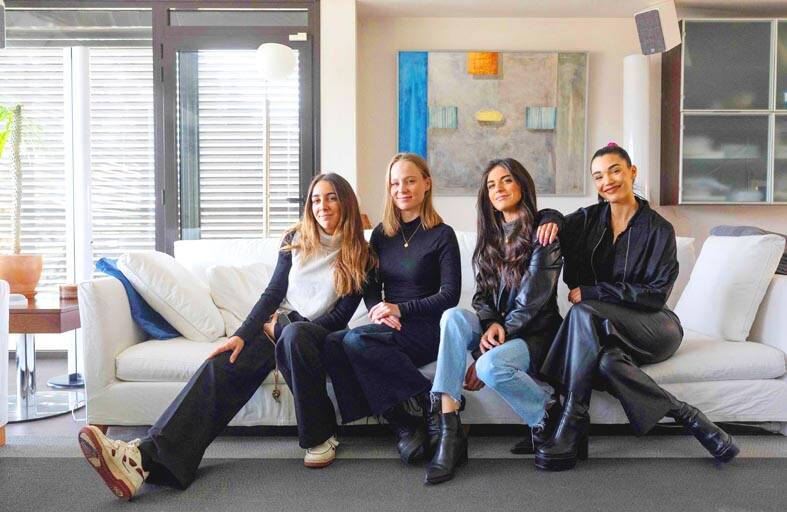In the suburbs of Madrid, four young women are hard at work creating videos summarizing the news that is viewed every day by millions of people on TikTok.
They are part of a growing army of young people making content about current events that attract more viewers on social media than videos published by traditional media. The idea emerged when two of the women were studying in London between 2016 and 2020, as Britain was preparing to leave the EU.
“We would read a bunch of articles, but we weren’t able to get a broad understanding” of the topic, 26-year-old biotechnology graduate Gabriela Campbell said.

Photo: AFP
“We thought if it’s hard for us, there must be more people like us, too,” she said.
So the pair joined forces with two other friends to launch an account on TikTok called “ac2ality” in June 2020, just as the popularity of the Chinese short-video sharing app was soaring among young people.
Nearly three years on, the account has 4.3 million followers — more than the majority of major media outlets.
That makes ac2ality the top news account in Spanish on TikTok, the University of Oxford’s Reuters Institute for the Study of Journalism said.
The four do not consider themselves journalists, saying instead they “translate the news” in one-minute videos made with a smartphone and a circular light to ensure well-lit images.
Their video narrating the start of Russia’s invasion of Ukraine on Feb. 24 last year was seen more than 17 million times.
Social networks such as YouTube, Instagram and TikTok have become the main source of news for young people, according to several studies, including one by Britain’s media regulator Ofcom.
Some initiatives offering news content “designed by young people for young people,” such as French firm Brut, have already become heavyweights, Reuters Institute researcher Nic Newman said.
Thanks to algorithms, news accounts run by individuals and “not necessarily companies” can now “reach huge numbers of people” on social media, he said.
In France, HugoDecrypte is one of the most followed news accounts on social media, and has broadcast interviews with French President Emmanuel Macron and Bill Gates.
Its founder, 25-year-old YouTuber Hugo Travers, said he knows “how to talk to a generation” that simply “tunes out” when news is presented in a more traditional format.
Susana Perez Soler, a journalist and digital communications expert at Barcelona’s Ramon Llull University, said such accounts owe their popularity to their lighter tone, creative formats and short lengths.
In cases like ac2ality, they are providing a “summary” of the news and “not journalism,” which requires “investigative work, finding sources and checking their reliability,” she added.
The millions of subscribers these accounts attract have aroused the envy of major media outlets, which struggle to reach young people.
A large Spanish media firm made a bid for ac2ality, but the four founders wanted to maintain their independence.
Cofounder Daniela Alvarez said “one of the keys” to ac2ality’s success was “not being associated with the mainstream media,” which can sometimes be “politicized” or burdened by cumbersome procedures.
Some journalists who work for traditional media also run their own news accounts on social media.
Sophia Smith Galer, a 28-year-old British journalist with Vice News, has an account on TikTok where her videos on sexual health have been watched more than 130 million times.
“You don’t have to convince a gate-keeping news editor why a story is important,” she said.
“I am my own editor on that,” she said. “What young people consider to be newsworthy is not necessarily what traditional news media think is newsworthy.”
Those between 15 and 30 do still turn to traditional media in some cases, Newman said.
“When you talk about something like Ukraine, a lot of young people don’t want that presented to them by 18-year-olds,” he said.
“They want the news presented by people who are actually in the war zone and really know what they’re talking about,” he said.

In the sweltering streets of Jakarta, buskers carry towering, hollow puppets and pass around a bucket for donations. Now, they fear becoming outlaws. City authorities said they would crack down on use of the sacred ondel-ondel puppets, which can stand as tall as a truck, and they are drafting legislation to remove what they view as a street nuisance. Performances featuring the puppets — originally used by Jakarta’s Betawi people to ward off evil spirits — would be allowed only at set events. The ban could leave many ondel-ondel buskers in Jakarta jobless. “I am confused and anxious. I fear getting raided or even

Kemal Ozdemir looked up at the bare peaks of Mount Cilo in Turkey’s Kurdish majority southeast. “There were glaciers 10 years ago,” he recalled under a cloudless sky. A mountain guide for 15 years, Ozdemir then turned toward the torrent carrying dozens of blocks of ice below a slope covered with grass and rocks — a sign of glacier loss being exacerbated by global warming. “You can see that there are quite a few pieces of glacier in the water right now ... the reason why the waterfalls flow lushly actually shows us how fast the ice is melting,” he said.

Eleven people, including a former minister, were arrested in Serbia on Friday over a train station disaster in which 16 people died. The concrete canopy of the newly renovated station in the northern city of Novi Sad collapsed on Nov. 1, 2024 in a disaster widely blamed on corruption and poor oversight. It sparked a wave of student-led protests and led to the resignation of then-Serbian prime minister Milos Vucevic and the fall of his government. The public prosecutor’s office in Novi Sad opened an investigation into the accident and deaths. In February, the public prosecutor’s office for organized crime opened another probe into

RISING RACISM: A Japanese group called on China to assure safety in the country, while the Chinese embassy in Tokyo urged action against a ‘surge in xenophobia’ A Japanese woman living in China was attacked and injured by a man in a subway station in Suzhou, China, Japanese media said, hours after two Chinese men were seriously injured in violence in Tokyo. The attacks on Thursday raised concern about xenophobic sentiment in China and Japan that have been blamed for assaults in both countries. It was the third attack involving Japanese living in China since last year. In the two previous cases in China, Chinese authorities have insisted they were isolated incidents. Japanese broadcaster NHK did not identify the woman injured in Suzhou by name, but, citing the Japanese